Knitting is one of the oldest and most common types of women's needlework. Openwork patterns with knitting needles began to appear a little later - since priority was initially given to dense knitting. When knitting became a hobby, handicraft, and not an urgent need, openwork patterns became popular. Now many are looking for patterns with descriptions, photos of openwork.
For an openwork scarf and stole
To knit an openwork scarf that will be appropriate at any time of year, except summer (due to the use of wool yarn), you will need:
- yarn – 125 g (48% wool, 18% mohair, plus synthetics);
- knitting needles No. 5;
- scheme.
Work process. The length of such a product will be 190 cm, and the width is 30 cm, the knitting pattern is zigzag. The number of loops in the knitting pattern is a multiple of 8 (excluding two edge loops). The schematic image of the pattern shows the front side. The back side, in turn, is knitted according to the pattern, but the yarn overs are made with purl loops.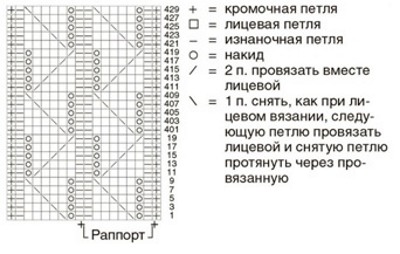
The first row of stitches (there are 58 of them) must be cast on both knitting needles, otherwise the edges of the scarf will be pulled together. The approximate number of rows is 400-430, with the pattern repeating 20 times. A stole with an openwork pattern knitted on knitting needles can become a wonderful element of a basic wardrobe not only for the cold season, but also for the summer period.
Such a stole can be thrown over the shoulders during an evening walk. To make such a product yourself, it is best to take yarn based on alpaca and silk (100 g), knitting needles - No. 3.5, circular. Initially, for a width of 53 cm and a length of 220 cm, you will need to cast on 84 loops and knit the first two rows with garter stitch.
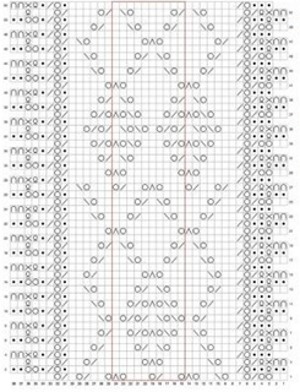
Next, knit according to the pattern.
For children's things
Craftswomen who prefer to knit children's things willingly use openwork patterns with knitting needles, diagrams with descriptions, photos of interesting models and advice from handicraft forums. Even the most ordinary model of a dress or a blouse, a cape, can be turned into an elegant product if you choose the right combination of openwork pattern and the shade of the threads themselves.
The choice of openwork largely depends on the functionality of the item itself - children's styles can have a relief, but at the same time quite elegant pattern, and this does not affect the density of the knitting.
For children's things, they mainly use such openwork, in which transparency is reduced to a minimum. First of all, because a thin airy thing can quickly become unusable. This is especially true when it comes to knitting pullovers and sweaters.
A similar knitting option, when the original pattern is quite durable, but at the same time interesting and beautiful, is perfect for decorating clothes for both boys and girls.
The basic part of the pattern with a branch and leaves is 12 loops and 74 lines. Many craftswomen, knitting children's things, especially dresses, limit themselves to openwork trim of sleeves, neck and hem. And in this version, the outfit looks more adult and elegant.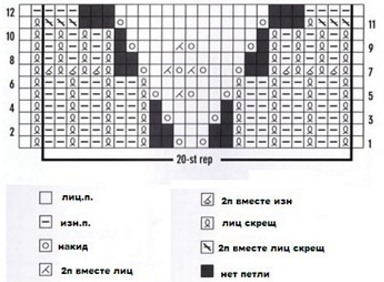
This type of border can be knitted without any particular difficulties.
For a summer sweater
In order for a summer knitted sweater to not only please the eye, but also be pleasant to the body and look appropriate on a sunny day, you need to choose the right yarn for the product. Experienced craftswomen advise choosing a natural thin thread that will consist of at least half cotton.
An important nuance that should not be forgotten when cotton threads are chosen for knitting is that they have a low degree of elasticity. A thing made of such material should be regularly tried on, “tried on” to the body, to understand that the work is going according to plan. According to the designers, In the new season, mesh and patterns depicting different types of leaves will be in fashion for summer clothes.
This particular type of openwork knitting patterns has dozens, if not hundreds of execution options, each of which deserves special attention. Schemes with descriptions and photos of samples are a clear confirmation of this.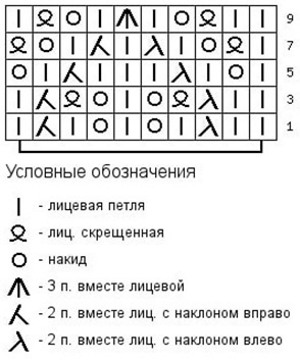
In addition to mesh and leaf motifs, geometric patterns will be popular for summer sweaters this season – both solid and alternating with garter stitch. 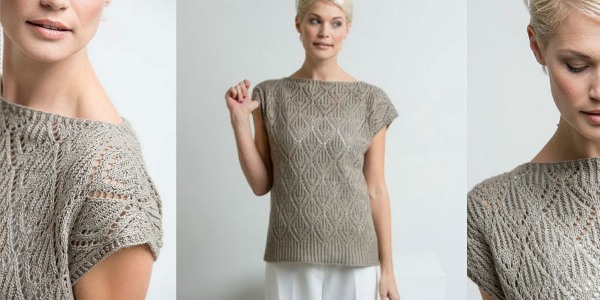 This combination is recommended for ladies of elegant age who are not afraid to experiment with their image.
This combination is recommended for ladies of elegant age who are not afraid to experiment with their image.
For a cardigan
A cardigan is an elongated sweater that has neither a collar nor lapels. It is usually fastened with buttons or a belt. Knitted cardigans can differ from each other in knitting density and texture - depending on the season, dense or loose knitting, large or small openwork patterns with knitting needles are relevant.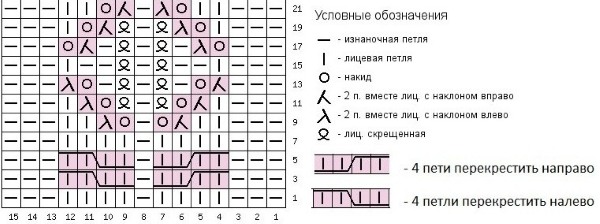
For an airy, light thing, such a pattern as openwork paths will be appropriate - there is no great need to describe such a scheme. The repetition of the basic element of the pattern consists of 17 loops, 2 of 17 are edge loops, and 3 are necessary for the symmetry of the left edge. The height of the pattern is 22 rows.
Some simple and beautiful openwork patterns for beginners
Looking at some filigree openwork patterns, it seems that such perfection of knitting can be achieved only with years of continuous training, comprehending the subtleties, reading descriptions, diagrams and studying photos and videos of the process. However, as needlewomen claim, there are patterns, the complexity of which even an inexperienced craftswoman can comprehend.
The first version of the pattern is very simple and is often used both as a base and in combination with other, more complex patterns:
- The basic ornament includes 8 loops, 2 of which are traditionally edge loops. The ornament is 8 lines high.
- First row – 4 front loops, yarn over, 2 loops together front, tilted to the left.
- Second line – 4 purl loops, 2 loops together purl, tilted to the right. Then follows a similar alternation.
Another example of openwork knitting will allow you to create stylish and original things quickly and easily. This pattern is suitable for both a stole and a summer beach tunic.
Mating:
- The first three rows are knitted with the front surface.
- In the fourth row, next to each front loop, 2 yarn overs are made, i.e. front loop, 2 yarn overs, front loop, 2 yarn overs, etc., until the edge loop.
- The fifth row is again worked in stockinette stitch, but the yarn overs near each stitch are dropped, pulling the stitch up to its full height.
The third option is an openwork mesh and is an excellent trainer for openwork knitting:
- First row – purl stitch.
- Second row - purl loop, 2 loops together with purl, 2 loops together with purl.
- Third row - purl loop, 1 purl loop, pulled out from yarn over, purl again, 1 purl loop, pulled out from yarn over, purl.
- Fourth row: 2 loops together with purl, yarn over, 2 loops together with purl, yarn over, 2 loops together with purl.
For socks
The fashion for openwork knitting of socks and mittens encourages fashionistas to master openwork patterns with knitting needles on their own. After all, a real exclusive can only be obtained as a result of handwork. There are plenty of patterns with descriptions, and step-by-step photo and video master classes allow you to master the skill without resorting to the services of mentors.
To make the work of the craftswomen easier, the manufacturers have taken care of special sock yarn - which is 70% wool, the rest is synthetic thread. The balance of "warmth/wear resistance" declared by the manufacturers is fully justified.
Openwork knitting for socks requires adherence to certain rules:
- Firstly, the “running part” – i.e. the toe, heel, and sole – are made with a dense front surface.
- Secondly, openwork parts should alternate with dense knitting.
- Thirdly, the openwork elements themselves should not be too large. Craftswomen advise using such elements as paths, leaves and braids in knitting.
These three options are the most suitable for products of this kind and will allow you to maintain a balance of beauty and warmth.
The original openwork pattern for socks is a bit reminiscent of a mandala - symmetrical elements repeated in a square. This pattern is knitted starting from the center and covers the front part of the foot to the instep. Next comes the leaf pattern, which is also visible in the central part of the ornament.
Another version of the sock pattern resembles a plant motif. However, upon closer inspection, a greater resemblance to scales is seen.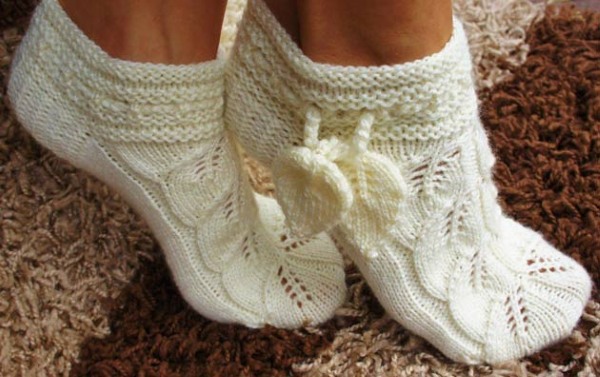
Another variation of the pattern for socks suggests making only the “shaft” openwork – the main part of the sock is knitted tightly, and from the ankle joint the sock widens slightly.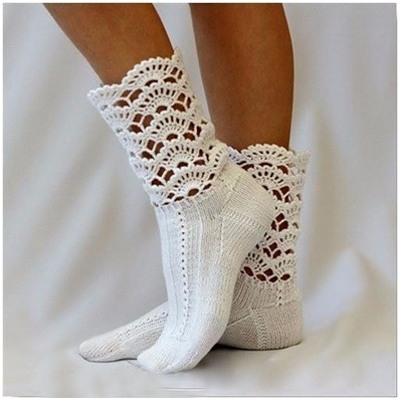 The pattern, reminiscent of fans or shells, looks spectacular when made with white yarn..
The pattern, reminiscent of fans or shells, looks spectacular when made with white yarn..
Openwork leaves
This pattern is considered neutral and is equally well suited for women's items of various styles. Even if the item itself is made without openwork patterns, the leaves, crocheted with jewelry, will be a wonderful addition and will serve as an original accent to the image. The main pattern in the form of leaves can be of various types and differ in shape, size and openwork of the leaves themselves.
A similar pattern is also ideal for a stole or shawl and is easy to knit. The rapport is only 5 loops and 22 rows, the nuance is that in the process of knitting the number of loops "plays" - from one loop seven loops are knitted, forming the base of the leaf, subsequently this number is reduced, forming the shape of the leaf itself.
Vertical openwork
A vertical pattern in clothing visually stretches and slims the silhouette, and this little trick is widely used by clothing designers, fashion designers, and anyone who is directly involved in making clothes on their own. Knitting is no exception – openwork patterns with knitting needles, on the contrary, open up wide opportunities for fashionistas.
A simple, yet elegant vertical pattern of medium knitting density is perfect for a cardigan, a summer sweater, and a top. Here is an example of a description and diagram, a photo of vertical openwork. The main, basic fragment of the ornament consists of 4 rows and 4 loops. To make the edges more even and beautiful, you can additionally knit two loops at the very beginning of the row, and one at the end.
Mating:
- First row: purl stitch, three knit stitches.
- Second row: knit stitch, three purl stitches.
- Third row: purl stitch, yarn over, knit 3 stitches together, yarn over.
- Fourth row: knit stitch, three purl stitches.
Zigzags
This original pattern looks good on shawls and stoles, and perfectly complements the item as a finishing element. The zigzag looks especially impressive if the yarn for the work is sectional or ombre. The classic transition from a lighter to a darker shade will look advantageous on a skirt of maximum length.
A separate category of using the zigzag pattern is blankets. Home fashion has again turned to knitted accessories and little things that create coziness. A tablecloth and a blanket, the motifs of which echo, but not so much that the items can be confused - this is good form. But if the zigzag pattern is used, this is the highest level.
Stripes and tracks
These openwork patterns for knitting needles can serve as a wonderful trainer for beginner knitters. Thanks to these patterns, you can get your hand in and practice key elements to automatism, because the stripes and tracks mostly consist of yarns and elements knitted together.
Openwork stripes and paths can also be used as a pattern for the main fabric – for a beach tunic or dress, for example.
Another option for using these patterns is as inserts into the main fabric, to soften the strict image. The most basic tracks can be easily modified by increasing or decreasing the number of loops between the tracks, changing the angle of the loops knitted together, or changing the location of the yarn over.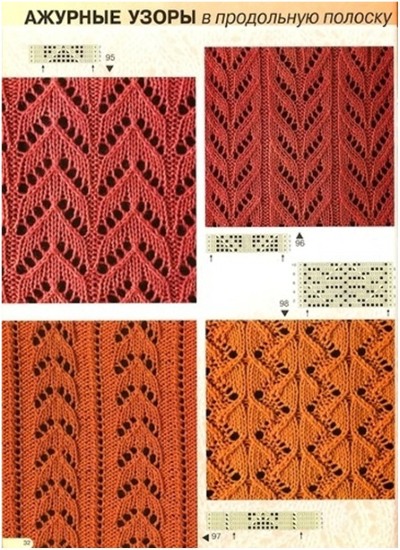
The most common variants of vertical stripes look like alternation of more convex small patterns and openwork holes. At the same time, the overall pattern can form braids, as in the diagram, spikelets or other plant motifs.
Openwork paths made on knitting needles can also be of various modifications. The most common are the options presented in the diagram - the path of holes does not necessarily go strictly along the ruler - it can form a rounded bend, or a zigzag.
Openwork braids
For many, openwork braids in knitting are the very favorite classics that cannot be abandoned. Knitted braids are found not only on women's clothing. You can often find men's pullovers decorated with this particular pattern, however, in a rougher execution, large knitting with thick thread is much more appropriate than openwork.
Women's dresses and pullovers with openwork braids are classics that enjoy constant success.
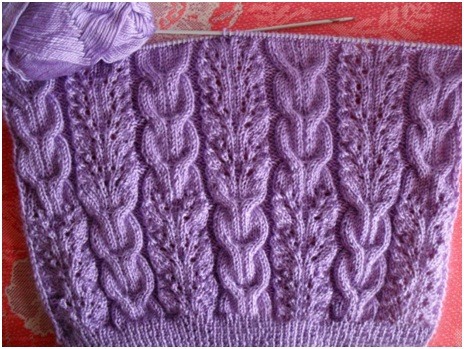 The relief of the openwork braid is created by combining yarn overs and knitting several loops together. In addition to the usual openwork braids, there is a separate category of patterns - arans. The so-called Aran knitting is a harmonious Celtic pattern made up of braids.
The relief of the openwork braid is created by combining yarn overs and knitting several loops together. In addition to the usual openwork braids, there is a separate category of patterns - arans. The so-called Aran knitting is a harmonious Celtic pattern made up of braids.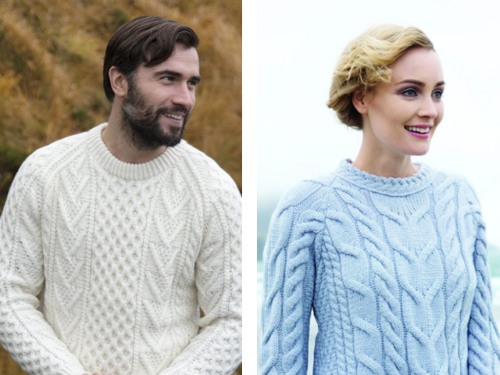
The pattern can be made up of abundant interlacing or single combinations of elements – everything depends on the imagination of the craftswoman and the purpose of the item. Winter jumpers, cardigans and dresses are most densely saturated with knitted braids. For summer clothes, a more delicate and small pattern is used.
Openwork with elongated loops
The elongated loops in the openwork knitting fabric look very aesthetically pleasing, but in addition to its visual appeal, such a pattern is also characterized by softness and elasticity, which makes wearing such a thing even more pleasant.
Elongated loops can be knitted with knitting needles using yarn overs.
To do this, you need to knit several rows of stocking stitch (3-4 will be enough). Then, in the next row, after each front loop, you should make two or more yarns - the length of the pulled loop will depend on the number of yarns. In the next row, before knitting the loops, you need to drop the yarns and pull out a long loop with the right knitting needle using them.
Next, you need to put the elongated loop on the left knitting needle and continue knitting according to the pattern. If you knit the entire row in turn, you will get an openwork translucent section of elongated loops. An elementary pattern is four rows of tight knitting - a row with elongated loops. By combining these two simple techniques, you can get an impressive number of knitting options.
Openwork corners
This type of pattern is mainly used for finishing edges and armholes and is not very common, since many craftswomen find it easier to do the same work with a crochet hook. However, true adherents of knitting do not see any particular difficulties and perform this pattern with their usual tool.
For such a pattern you need thin yarn and fairly thin knitting needles - then the pattern will turn out perfectly openwork and airy.
Sometimes the openwork diamonds that make up the main knitting pattern of the fabric turn into corners at the edge – such a transformation looks harmonious and impressive, and the quality of the edge does not suffer from this. In addition, openwork corners are used not only to decorate clothes, but also to decorate the corners of blankets, tablecloths, shawls and stoles.
For most openwork corners, zigzags are used., diamonds and squares – working with regular geometric shapes makes it easier to achieve the desired rigor of the pattern and the product as a whole. However, in addition to these figures, a fairly common pattern is a mesh in combination with various motifs and even braids.
However, in addition to these figures, a fairly common pattern is a mesh in combination with various motifs and even braids.
Openwork diamonds
Despite the fact that the rhombus is a rather strict geometric figure, many needlewomen modify it somewhat, adding fantasy and softness to the shape. The results are striking in their beauty and elegance. There are many varieties of openwork rhombuses - they add edgings, constrictions, cones, leaves, and many other additional figures.
Diamonds, openwork made on knitting needles, are used for knitting women's clothing - sweaters, pullovers, dresses, capes, stoles and skirts. Since the size and frequency of the pattern vary arbitrarily, the diamond is suitable for both children's and teenage clothing.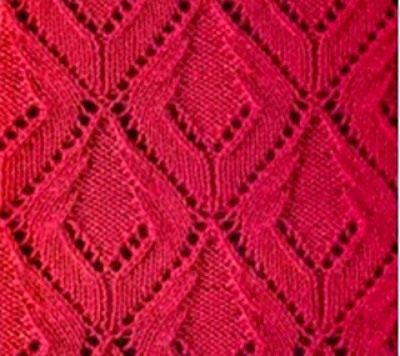
An unusual pattern with an openwork rhombus is shown in the diagram: the rhombus itself is formed by a mesh, and inside it there is another openwork element, more convex, in the shape of a herringbone. 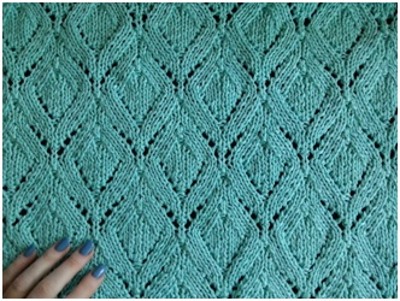 Another version of the pattern with diamonds consists of relief, volumetric elements that completely fill the fabric. The knitting itself is dense, but this does not affect the openwork of the pattern.
Another version of the pattern with diamonds consists of relief, volumetric elements that completely fill the fabric. The knitting itself is dense, but this does not affect the openwork of the pattern.
Japanese patterns and ornaments
It is difficult to say how Japanese patterns and ornaments differ from the generally accepted openwork patterns on knitting needles at first glance. There are no striking differences, or special patterns or details as such. However, the Land of the Rising Sun has always been famous for its love of detail and the thoroughness of any work. Knitting is no exception.
The complexity of the pattern is the only characteristic feature inherent in Japanese patterns and ornaments. One pattern can contain from two to five additional patterns - for example, a braid, in addition to the braid itself, will also contain leaves, diamonds, cones and plant motifs.
Fine openwork
Not all craftswomen choose large patterns for their work, many prefer small openwork. Such a pattern meets many requirements - it looks interesting, while its density does not increase heat transfer. Knitting small openwork is easier and more interesting than other patterns. For example, the rapport of the Bulgarian cross pattern for knitting needles consists of only one yarn over and three loops.
This openwork pattern looks most advantageous when made with cotton yarn.
Despite its name, the pattern does not consist of crosses, but of intricately twisted fragments, the frequent repetition of which creates an interesting design.
With wavy edge
Openwork patterns with knitting needles with a wavy edge, as well as openwork corners, are quite often used to decorate edges and armholes. An elegant and effective pattern can give a thing a special charm. The diagrams with a description indicate a characteristic feature of this pattern - the number of loops in the rapport can change from row to row.
Photos of finished works prove that the wave is often used as an independent pattern and is used for knitting dresses, sweaters and cardigans.

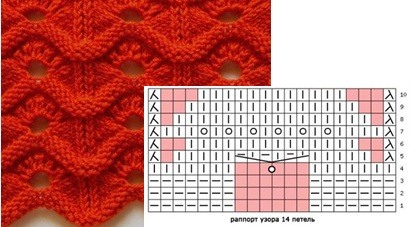
In this pattern, the wavy pattern alternates with the front surface and mesh. The item knitted with this pattern does not need additional decoration of the armholes and bottom, since the pattern itself is elegant.
This version of the openwork knitting pattern is interesting due to the combination of a relief, convex wavy line, into which an openwork arch is inscribed. The diagram with the description clearly shows that all segments are additionally divided by a double track. In the close-up photo, you can make out all the details of the relief knitting and the originally selected elements.
The availability of knitting, a huge variety of openwork patterns and schemes, at the same time leaving room for creativity, a rich palette of yarn - all this allows you not only to enjoy the process, but also to please yourself and others with a beautiful and practical product as a result.
Video: openwork patterns with knitting needles. Schemes with descriptions, photos
Technique for making an openwork pattern with knitting needles:
How to knit an openwork stole with knitting needles, watch the video:

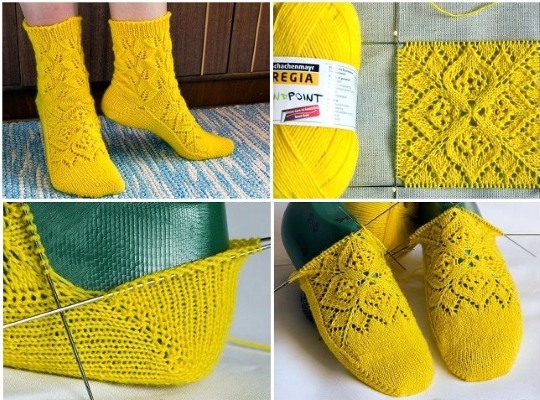
I just love varying the striped pattern! The product will always look very advantageous. A vertical stripe on a sweater, for example, can create the impression of an elongated, tall figure.
I also often use the "Braid". The loops in this pattern are slightly offset, which makes the product look like a woven birch bark basket. For example, when knitting hats - they are pleasing to the eye and keep your head warm. Braiding looks good with braids and arans, which allows you to create large products - for example, sweaters.
The number of loops should be divisible by 6, two more are collected for the edge. Knitting occurs on the front side, from the back - with purl loops. After 8 knitted rows, the pattern is repeated.
The only thing that might be off-putting about this pattern is the need to constantly remove and transfer stitches, but, overall, this pattern cannot be called the most difficult.